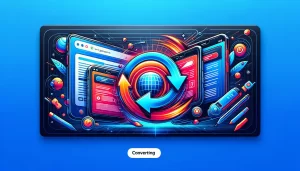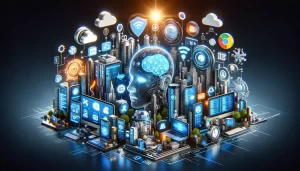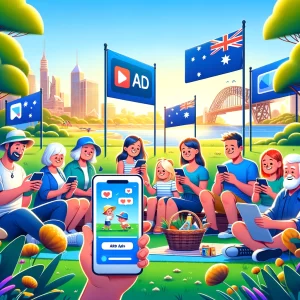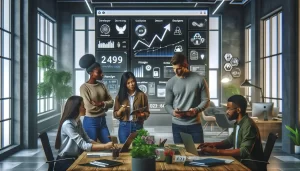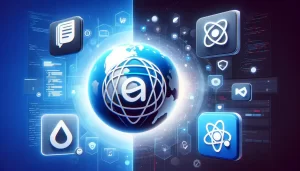Web technology has changed a lot since the start of the World Wide Web. Back then, it was just about making simple web pages. Now, it includes a lot more technologies and ways of doing things. It’s been a big change from using basic HTML to now using fancy JavaScript frameworks.
The significance of web development on a global scale is unmistakable. Businesses, from small startups to multinational corporations, recognize the essential need for an online presence in the digital age. This widespread adoption of digital solutions has led to an exponential growth in the demand for Web Development Services. As the world increasingly embraces the digital wave, the field of web development finds itself at the forefront of constant transformation and innovation.
The evolution of web development technologies is a testament to this ongoing revolution. From the basic markup language of HTML to the sophisticated styling capabilities offered by CSS and the introduction of dynamic interactivity through JavaScript, each advancement has shaped how we experience the web. These technologies have empowered developers to create more visually appealing and functional websites and paved the way for entirely new forms of online interaction.
Exploring the Web Development Journey through Time
Hey there! Let’s take a look through the history of the web!
The Birth of Websites and HTML
Back in 1991, Sir Tim Berners-Lee created the World Wide Web. Websites were basic back then, just simple documents made with Hypertext Markup Language, or HTML for short. It was like building blocks for web pages and letting developers create links between them, which was pretty cool then.
Introducing CSS
As the internet grew, people wanted their websites to look cooler. That’s when Cascading Style Sheets, or CSS, came onto the scene in the late 90s. CSS lets developers control how their pages look, separating the style from the content. This was a big deal because it meant more flexibility and prettier designs.
Enter JavaScript
Then came JavaScript in the mid-90s, letting developers make their websites do all sorts of fancy things. It was like magic! Suddenly, websites weren’t just static pages anymore. They could be dynamic and interactive, thanks to JavaScript. This opened the door to all sorts of cool stuff, like single-page applications.
The Web Technology Revolution: A World of Possibilities
In 2024, there’s a big change happening in web technology. It’s like a race full of new ideas that are making websites better. We’re seeing exciting advancements that are shaking up how we use the internet.
This web technology revolution isn’t just about fancy gadgets or complicated stuff. It’s about making things easier for everyone. Whether you’re browsing on your phone or shopping online, these new technologies are here to make your life simpler. From faster-loading pages to personalised experiences, the goal is to make the internet more user-friendly and enjoyable for everyone. So, get ready to dive in and discover how these innovations are transforming the way we connect and interact online!
Bridging the Gap Between Websites and Mobile Apps with Progressive Web Apps (PWAs)
Progressive Web Apps (PWAs) are like a cool hybrid of websites and mobile apps. They give you the best of both worlds! Imagine having an app-like experience right in your web browser. With features such as push notifications and offline access, PWAs make using websites feel just like using mobile apps. They’re super speedy and reliable, making sure you never miss a beat, whether you’re on your phone, tablet, or computer. No wonder businesses everywhere are loving PWAs!
Revolutionising Speed and SEO with Accelerated Mobile Pages (AMPs)
Nobody likes waiting around for a website to load, especially on their phone. That’s where Accelerated Mobile Pages (AMPs) come in to save the day! Accelerated Mobile Pages (AMPs), led by Google and Twitter, are now leading the way in making web pages load faster and getting better results on search engines. These special versions of web pages load super fast on mobile devices, giving you the speed you need without the wait. And here’s the best part: AMPs not only make users happy, but they also help your website rank higher in search engine results. So you get more visitors and better visibility – talk about a win-win!
Voice Search Optimization: A Vital Imperative
Have you ever asked Siri or Google a question instead of typing it? That’s voice search! And it’s changing the way we find things online. That’s why it’s crucial to optimize your website for voice search. By using natural language and targeting specific keywords, you can help your site show up more often when people use voice search. And with more and more folks talking to their devices, it’s an opportunity you don’t want to miss!
AI Chatbots for Redefining Customer Service Standards
Meet the future of customer service: AI chatbots! These virtual helpers are here to make your life easier. They can answer questions, solve problems, and even give recommendations – all without needing a break! With AI chatbots, you can provide instant support to your customers anytime, anywhere. It’s like having a customer service team that never sleeps! So why not give your business a boost with AI chatbots? Your customers will love you for it!
Augmented Reality (AR) to Transform E-Commerce Experiences
Imagine shopping online and being able to see how a piece of furniture would look in your living room before you buy it. That’s the magic of Augmented Reality (AR) in e-commerce web technology! It’s like adding a layer of digital information to the real world. With AR, e-commerce is becoming more interactive and fun. You can try on clothes virtually, see how makeup looks on your face, or even test out new gadgets – all from the comfort of your home.
Embracing Multi-Experience Development for Seamless User Interactions
Let’s make things easy for users with web technology! Multi-Experience Development is all about creating apps and websites that work smoothly across different devices and platforms. Whether you’re on your phone, tablet, or computer, you’ll have the same awesome experience every time. No more glitches or hiccups – just seamless interactions that keep you coming back for more!
Elevating Cybersecurity to Paramount Importance
As digital dependency escalates, cybersecurity assumes paramount importance. Leveraging AI-driven threat detection mechanisms and Blockchain integration, robust cybersecurity measures are indispensable for safeguarding user data and preserving digital trust.
Single-Page Applications (SPAs): Championing Speed and Fluidity
Single-Page Applications (SPAs) have garnered widespread popularity owing to their ability to deliver swift and fluid browsing experiences. By minimising server load times, SPAs offer users a seamless navigation experience, making them a preferred choice among developers and end-users alike.
Responsive Web Design: A Cornerstone of Modern Development
Responsive Web Design goes beyond passing trends, forming an important part of modern web development. Making sure websites work perfectly on different devices is really important for giving users a good experience and making sure websites show up well in search results.
Dark Mode UI: Beyond Aesthetic Appeal
Dark Mode UI isn’t merely about aesthetics; it serves practical purposes by reducing eye strain and conserving energy, thereby presenting a pragmatic choice for users and developers alike.
Mobile-First Design: Catering to the Smartphone Era
With smartphones reigning supreme, adopting a mobile-first approach is imperative for web development endeavours. By prioritising mobile optimization, websites can deliver enhanced user experiences and bolster their visibility in search engine results.
Headless CMS: Pioneering Content Management Flexibility
Headless CMS has revolutionised content management practices by decoupling content creation from delivery. This innovative approach enables seamless integration across diverse platforms, offering unparalleled flexibility and performance enhancements.
Serverless Architecture: Streamlining Deployment Processes
Serverless architecture shows how things can be done efficiently by getting rid of the complicated parts of managing servers. This lets developers focus completely on coding and coming up with new ideas. With serverless architecture, development happens faster and we can change things more easily.
Metaverse Integration: Exploring New Frontiers
The metaverse presents a realm of boundless possibilities, spanning industries from travel to healthcare. By facilitating immersive experiences and novel forms of user interaction, the metaverse heralds a new era of digital engagement.
Internet of Behavior (IoB): Personalization Reinvented
The Internet of Behavior (IoB) leverages user data to deliver personalised experiences tailored to individual preferences. By understanding user behaviour patterns, businesses can curate content that resonates with their audience effectively.
AI and ML: Cornerstones of Modern Development
Artificial Intelligence (AI) and Machine Learning (ML) are really important in modern web development. They help with things like testing automatically and making user experiences better. AI and ML are like the foundation of making web development better and faster.
Low-Code/No-Code Development: Empowering Creativity
Low-code/no-code development platforms make it easy for anyone to create web applications, even if they don’t know a lot about coding. These platforms simplify how things are made, letting more people be creative and take part in the digital world.
Cloud Computing: Enabling Unparalleled Flexibility
Cloud computing is all about being flexible and making things happen quickly. It’s like having access to a lot of resources whenever you need them. Whether it’s making development faster or keeping things safe, cloud computing is really important in the digital world.
CI/CD: Enhancing Development Velocity
Continuous Integration and Continuous Deployment (CI/CD) practices streamline development workflows, ensuring the seamless integration of high-quality code and expediting deployment cycles.
API-First Development: Prioritising Interoperability and User Experience
API-first development focuses on making different things work well together and making it easy for users. This helps different parts of a system connect smoothly and makes the experience better for everyone.
Mixed Reality (MR): Bridging Real and Virtual Worlds
Mixed Reality (MR) mixes parts of virtual and reality, giving very real experiences that go beyond normal limits. Using MR in web development lets people tell interesting stories in new ways and make user engagement better.
Push Notifications: Fostering User Engagement
Push notifications are important for keeping users engaged by sending them timely and important updates. Whether it’s for apps or websites, these notifications help users stay informed and connected, building strong relationships over time.
In 2024, the world of web development is experiencing significant changes. With new ideas and advancements, the internet is becoming more dynamic. We’re in an era of transformation, where possibilities abound. Let’s embark on this journey together, witnessing the evolution of web development. As we navigate through these exciting times, fueled by innovation and excellence, we’ll uncover a new era of digital ingenuity, shaping the future of the online world.















